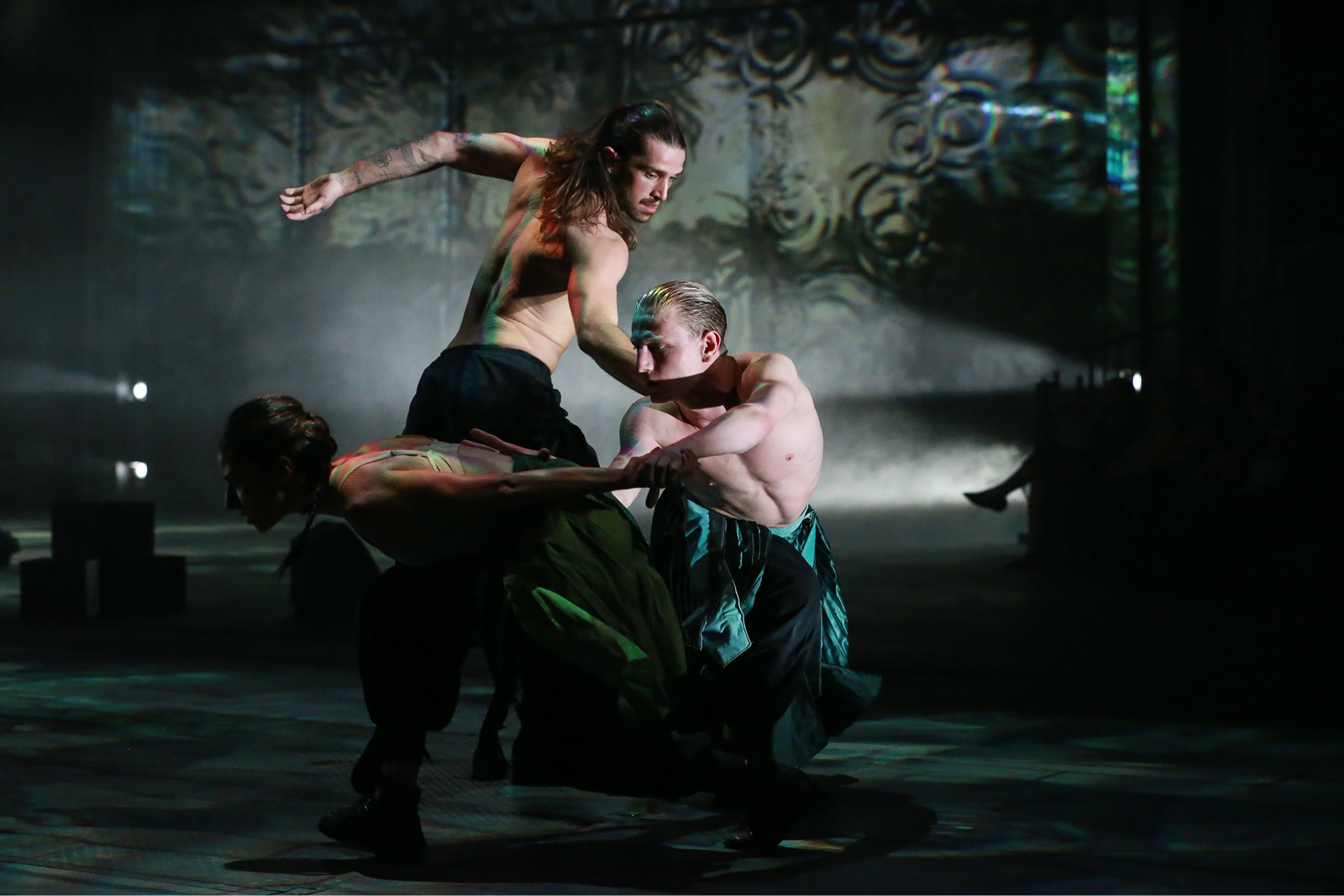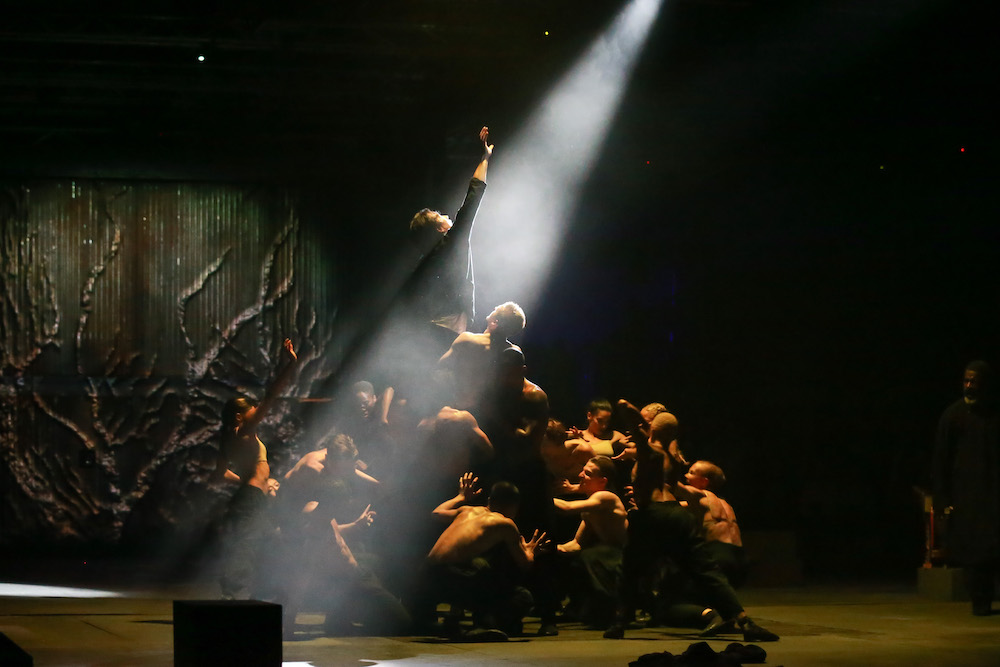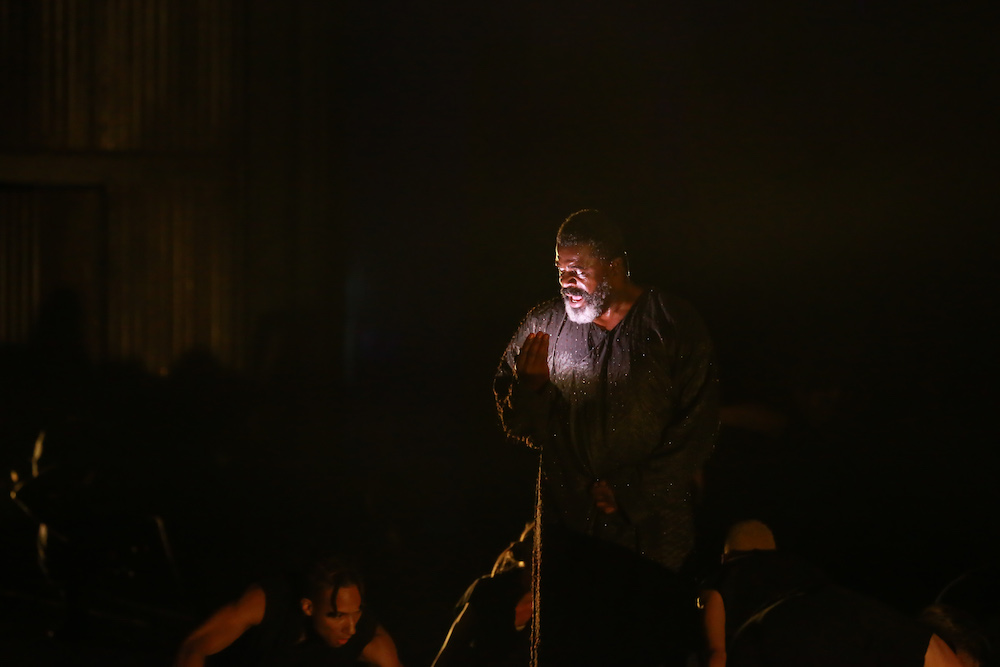Invisible Cities is one of the 2019 Brisbane Festival’s most anticipated works: a big, bold, ambitious undertaking of risky creativity.
 Invisible Cities. Photo © Justin Nicholas
Invisible Cities. Photo © Justin Nicholas
The exclusive five-night season presents precisely the type of production festivals exist for and which wouldn’t be possible outside the festival ambit. Premiering at Manchester International Festival in July, its scale and audacity recruited a team of conceptual and cutting-edge multimedia artists enlisting the gamut of theatrical tools, including projection-mapping video design, natural elements, adaptive set pieces and transformative props supporting two actors and 21 dancers. It aims to frame a nexus of humanity between performers and technology, in taking audiences on a contemplative philosophical journey through fantastical metaphoric worlds.
The name is a clue as to why this project is such a challenge, but more specifically it is the task of translating a novel of ideas founded firmly in the imagination into a live physical form for an audience. Since its 1972 release, Italo Calvino’s book has been largely considered impossible to stage, but Invisible Cities‘ director Leo Warner was determined to find a way.
He declares in his program notes that it is for the audience to decide whether Invisible Cities is one of his best ideas, an act of pure folly or, perhaps, both. Like the book’s two protagonists, Venetian explorer Marco Polo and Mongol emperor Kublai Khan, the Englishman is an adventurous spirit – he and his team at 59 Productions created the video design for the 2012 London Olympic Games opening ceremony watched by a billion viewers – and the arts thrive on the philosophy of who dares, wins.
While in my analysis Invisible Cities might not quite pull off the impossible, there is no folly. The success of this work is as much in the attempt as the outcome, because that is how we move forward.
Invisible Cities takes the theatrical imperative of creating a world out of an empty space a step further, by first transforming a cavernous vacant warehouse into an ephemeral bespoke auditorium for an audience of 1050. With the floor forming an expansive stage area flanked by raked seating banks on the North, South, East and West corners, we can imagine we’re time travellers in an ancient amphitheatre observing the exchanges between these 13th-century pioneers.
In adapting an episodic novel without a clear narrative Lolita Chakrabarti has sought to honour its esoteric mood, language and mysticism. In the dialogue-driven establishing scenes between Khan and Polo, the starkness of the staging is somewhat distancing, and it takes a while for the work to gain momentum. In addition to dialogue, Chakrabarti provided guidance for visual and movement aspects, and the realisation of these is Invisible Cities‘ most special and effective aspect.
 Invisible Cities. Photo © Justin Nicholas
Invisible Cities. Photo © Justin Nicholas
Viewing in the round offers a sense of inclusiveness, and the semi-transparent sectional curtains compartmentalising each audience quarter at times provide intimacy. The immersive experience of virtually-voyaging through an array of geographical and elemental scenes projected on these front cloths between scenes is particularly evocative. These include heaving oceans contrasted with tranquil seas, teeming rain in a bamboo forest, celestial skies, sun-drenched sand dunes and silks bridging buildings. Later, macro-closeups transform into landscapes seen from different perspectives and distances.
As Polo describes each intriguing mythical metropolis to appease his aging captor, architectural details are mapped onto wall panels and the floor, the dancers’ physical expression and use of props further augmenting the imagery. They represent a stilt city, cathedral arches, constellations, a camel train, and vividly, monsters. The geometric reconfiguring of elastics and panels is visually striking while also generating a potent sense of confinement.
For dance aficionados Invisible Cities boasts a double allure: its dancers aren’t just any dancers, and their choreographer (also the work’s co-director) is renowned for his inventiveness and versatility. Rambert is one of the world’s most revered companies, a multicultural contemporary troupe with balletic roots, and Sidi Larbi Cherkaoui, a quirky cross-artform collaborator, is known to Brisbane Festival audiences for the hit Sutra performed with Shaolin monks.
Interval sees the stage transformed by a water-filled canal and gondola transporting us to Venice. It is an impressive achievement that signals a build in intensity alongside the movement transitioning more to pure dance, pulling us into whirling dervishes and Sufi-inspired orbs that highlight the Rambert troupe’s beautiful quality.
 Invisible Cities. Photo © Justin Nicholas
Invisible Cities. Photo © Justin Nicholas
The tale of a city that “has everything and more” unexpectedly delivers a powerful parallel with our modern lives, depicting a frenzy of consumerism and a landslide of excess. The hectic pace carries into a transit lounge baggage ballet, and a climax that’s played out in front of curtains spanning the width of the stage to create two hemispheres. This backdrop forming a close performance space produces the effect of zooming in on the dancers’ hypnotic flowing loops of movement.
Because of the text’s intellectual style, the epic scale of the staging and the sensory immediacy of the visual facets, the demands on the actors to connect and engage are equally huge.
Danny Sapani is a strong presence as Khan, but the distraction of Polo (Matthew Leonhart) speaking with a North American accent diluted the character’s impact (I wasn’t alone in feeling this). I had hoped for a more powerful overarching sense of profundity emerging from their dialogues – both need to bring a more commanding charisma to own the space, and cut through the other elements with greater emotional resonance. This was a preview performance so there is potential to achieve this during the season. (An exterior aspect that I also hope will improve to enhance patrons’ enjoyment is more efficient organisation of the parking at the venue. Unexpectedly long walks resulted in the stress of delayed arrivals.)
Invisible Cities is a unique experience and while its effect isn’t as contemplative as I’d hoped, it is a spectacular ride.
Invisible Cities is at the Brisbane Festival until September 28











Comments
Log in to join the conversation.